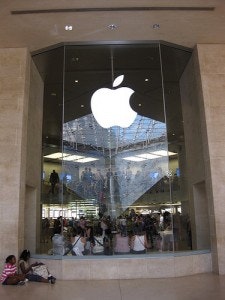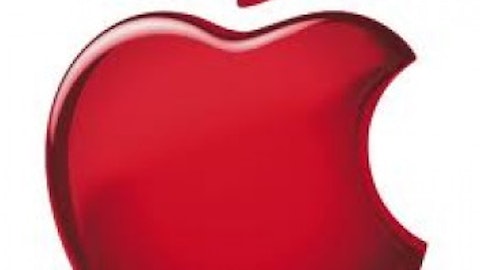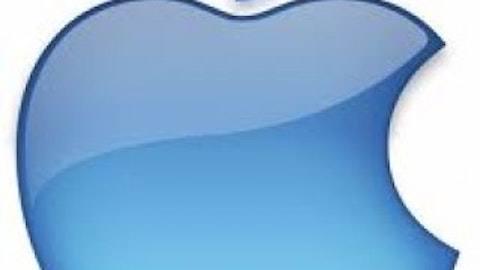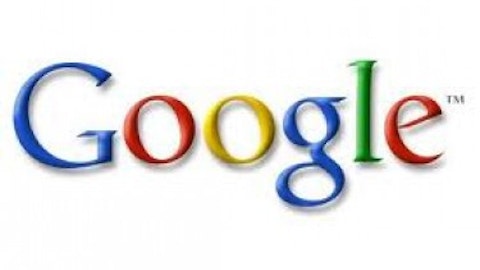Let’s make one fact clear: Apple Inc. (NASDAQ:AAPL) is not likely to grow as fast during the next five years as it did during the past five years. Annual growth of 70% is not sustainable forever, especially for a company that is expected to generate over $170 billion in revenue this fiscal year.
Analysts’ current expectations of 20% annual growth over the next five years are a more reasonable starting point for how to think about Apple going forward. As I wrote several months ago and will reiterate today, 20% growth combined with an unparalleled balance sheet simply can’t be reconciled with a price to earnings ratio of just 10.
Apple beat analyst expectations this quarter

Apple returns $100 billion to shareholders, and the market yawns
For years, one bearish view on Apple (and other companies with a sizable cash position) has been that the cash balance isn’t really relevant to the valuation of the company as a whole. The logic has been that the cash isn’t generating significant returns for the shareholder while it is sitting on the balance sheet, resulting in relatively low-performing assets weighing down the valuation multiple of a company. Alternatively, others argue that the net cash balance can be separated from the valuation of a company’s operations, but only at a discount.
I’ve argued that Apple Inc. (NASDAQ:AAPL)’s cash and operating assets should be valued separately, and that Apple’s $145 billion cash and investments should not be discounted unless it is receiving below-market interest rates. This model follows a well formulated case made by Aswath Damodaran on the subject of how to factor cash into the valuation of a company.
For those that continue to disagree with this philosophy, the use of Apple’s cash became significantly more clear (and near term) following Apple’s announcement that it will return $100 billion to shareholders during the next two years. This plan to maximize shareholder valuation includes the largest share buyback in history. Based on this stated plan to return cash to shareholders, the argument to value Apple Inc. (NASDAQ:AAPL)’s cash balance on a separate and undiscounted basis is even stronger than before even when factoring in some of the complications in repatriating portions of the cash balance.
Valuing Apple today
Apple has a current market capitalization of $404 billion; excluding cash and investments, this values Apple’s ongoing operations at $259 billion. Let’s take a quick look at Apple’s valuation metrics both including and excluding cash:
| Apple (Including Cash) | Apple (Excluding Cash) | |
|---|---|---|
| Market Capitalization (in billions) | $403.7 | $259.0 |
| TTM revenue (in billions) | $169.1 | $169.1 |
| TTM price to sales ratio | 2.39 | 1.53 |
| TTM earnings (in billions) | $39.7 | $38.3 |
| TTM price to earnings ratio | 10.17 | 6.76 |
| 5 Year expected growth rate | 20.9% | 20.9% |
| PEG ratio | 0.49 | 0.32 |
| TTM free cash flow (in billions) | $45.4 | $44.0 |
| TTM free cash flow yield | 11.2% | 17.0% |
| Source: Motley Fool CAPS and Yahoo! Finance – April 29, 2013 | ||
Excluding cash and the associated interest income of approximately $1.4 billion over the last 12 months, Apple Inc. (NASDAQ:AAPL) is trading at less than seven times earnings and less than six times free cash flow.
Apple is NOT Microsoft
Not only is Apple expected to grow more than twice as fast as Microsoft Corporation (NASDAQ:MSFT), the company is also trading at a discount to Microsoft using either valuation method above:
| Microsoft (Including Cash) | Microsoft (Excluding Cash) | |
|---|---|---|
| Market Capitalization (in billions) | $272.3 | $197.8 |
| TTM revenue (in billions) | $76.0 | $76.0 |
| TTM price to sales ratio | 3.58 | 2.60 |
| TTM earnings (in billions) | $16.4 | $15.8 |
| TTM price to earnings ratio | 16.60 | 12.52 |
| 5 Year expected growth rate | 8.5% | 8.5% |
| PEG ratio | 1.95 | 1.47 |
| TTM free cash flow (in billions) | $27.5 | $26.9 |
| TTM free cash flow yield | 10.1% | 13.6% |
| Source: Motley Fool CAPS and Yahoo! Finance – April 29, 2013 | ||
This comparison is clearly showing that Apple Inc. (NASDAQ:AAPL) is trading at a valuation that is significantly cheaper than Microsoft Corporation (NASDAQ:MSFT). I’d argue that this makes absolutely no sense given each company’s current product mix and future opportunity; that is not necessarily a criticism of Microsoft (or its current valuation), but is instead an indication of just how underpriced Apple’s shares are.



